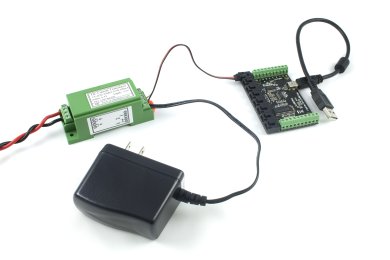This DC Current sensor measures DC current, up to 100mA. Powered by an external 12VDC power supply, the DC Current Sensor provides a 0 to 5VDC analog signal that is linearly proportional to the current measured at the terminal blocks.
The DC Current Sensor can easily be mounted using the screw holes, or on a 35mm wide DIN rail for quick installation. The terminal blocks accommodate conductors of up to AWG #16.
In order to measure the current, the sensor has an internal 5 Ohm resistor. This will result in a slight voltage drop before the voltage gets to the device requiring the power. Consequently, the “leftover” voltage might not be high enough to power the device, especially if the power supply has a voltage close to the device’s minimum voltage requirements. As a point of comparison, using a 12V battery running a 160 Ohm Load, there is an approximate drop of 0.375V due to the 5 Ohm sensing resistor on the 100mA DC Current Sensor. The maximum voltage drop is 0.5V, when the sensor is measuring 100mA.
The output of this sensor is not clamped at 5V. If the current being measured exceeds the rated input current, more than 5V will appear at the output signal. This can damage the Phidget Board (or any other ADC) that it is attached to if the output signal exceeds 5V for an extended period of time.
The current sensor connects to an analog input on Phidgets I/O boards. The formula to translate the SensorValue into Current is:
| Sensor Properties | |
|---|---|
| Sensor Type | Current (DC In-Line) |
| Sensor Output Type | Non-Ratiometric |
| Input Current Min | 0 A |
| Input Current Max | 100 mA |
| Measurement Error Max | 0.5 % |
| Sensor Response Time Max | 15 ms |
| Electrical Properties | |
| Supply Voltage Min | 12 V DC |
| Supply Voltage Max | 12 V DC |
| Current Consumption Max | 16.7 mA |
| Output Voltage Min | 0 V DC |
| Output Voltage Max | 5 V DC |
| Isolation Voltage (DC) | 2.5 kV DC |
| Isolation Voltage (AC) | 1.5 kV AC |
| Physical Properties | |
| Material | Plastic |
| Recommended Wire Size | 12 - 24 AWG |
| Operating Temperature Min | 0 °C |
| Operating Temperature Max | 50 °C |
| Customs Information | |
| Canadian HS Export Code | 9030.33.00 |
| American HTS Import Code | 9030.33.38.00 |
| Country of Origin | CN (China) |
You can use the 1144 - 12V Sensor Adapter to connect the voltage sensor to an analog input as pictured below.

Alternatively, you can use the 3002 - Phidget Cable 60cm or the 3004 - Phidget Cable 350cm to connect the DC Current Sensor to your Phidget. Just snip off the connector from one end of the Phidget cable and connect the wires as described below. You can also use a 3031 – Female Pigtail if you don't want to cut the barrel jack off of the power supply.


For boards that have power input, such as the 1019 or the 1073, if the supplied power is 12V, then the + terminal block on the Phidget Board can be connected to the voltage sensor terminal 5 (+12V), and the G terminal block on the Phidget Board can be connected to the sensor terminal 6 (-).
In order to use one of these power supplies with this sensor, you must cut the small plug from the end of the power supply and connect the wires directly into the sensor. You can also use a 3031 – Female Pigtail.